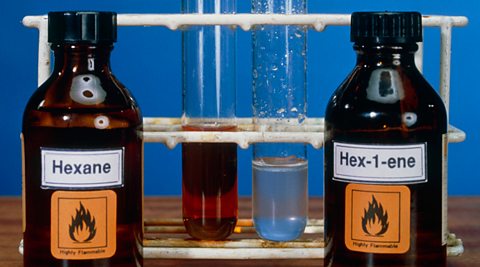Reactions of alkanes and alkenes
alkaneSaturated hydrocarbon. A compound of hydrogen and carbon only, with no C=C bonds. and alkeneUnsaturated hydrocarbon with a double bond between the carbon atoms. both undergo complete combustionBurning in a plentiful supply of oxygen or air. Complete combustion of a hydrocarbon produces water vapour and carbon dioxide., but only alkenes can undergo addition reactionType of reaction in which two substances react together to form one new substance..
Complete combustion
The complete combustion of alkanes and alkenes involves the oxidationThe gain of oxygen, or loss of electrons, by a substance during a chemical reaction. of hydrocarbonA compound that contains hydrogen and carbon only.. In both cases, carbon dioxide and water are produced. For example:
ethane + oxygen → carbon dioxide + water
C2H6(g) + 3½O2(g) → 2CO2(g) + 3H2O(l)
ethene + oxygen → carbon dioxide + water
C2H4(g) + 3O2(g) → 2CO2(g) + 2H2O(l)
Notice that more moleculeA collection of two or more atoms held together by chemical bonds. of oxygen are needed to balance the equation for ethane, because more water molecules are formed.
Addition reactions of alkenes
The functional groupAn atom, or group of atoms, that determines the main chemical properties of an organic compound., C=C, allows alkenes to undergo addition reactions.
For example, ethene reacts with water (in the presence of heat and a catalyst) to produce the alcohol ethanol.
Addition polymerisation uses addition reactions to turn alkenes into polymers. For example ethene becomes poly(ethene).
Ethene can also react with bromine to form 1,2-dibromoethane:
CH2=CH2 + Br2 → CH2BrCH2Br
It is easier to see what happens using structures with all their covalent bondA bond between atoms formed when atoms share electrons to achieve a full outer shell of electrons.:
The reaction is an addition reaction because one molecule combines with another molecule, forming one larger molecule and no other productA substance formed in a chemical reaction..
Worked example
Propene, CH2 = CHCH3 reacts with bromine. Predict the structure of the product formed.
The structure will be: CH2BrCHBrCH3
Question
Butene, CH2 = CHCH2CH3, reacts with bromine. Predict the structure of the product formed.
The structure will be: CH2BrCHBrCH2CH3
Testing for alkanes and alkenes
An orange-brown solution of bromine dissolved in water, called bromine water, is used to distinguish between alkanes and alkenes:
- there is no change when bromine water is mixed with an alkane
- the bromine water becomes colourless when it is mixed with an alkene
